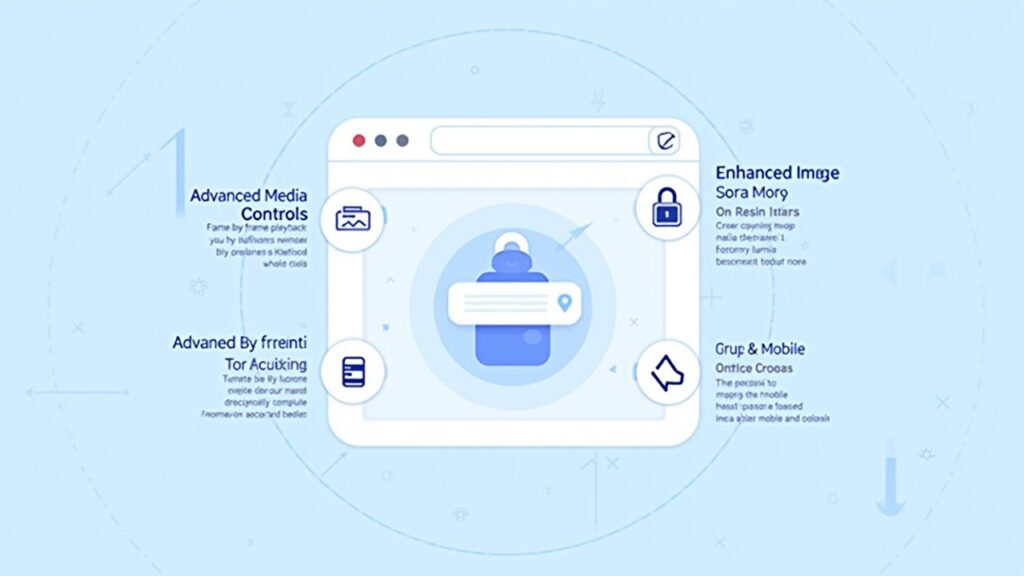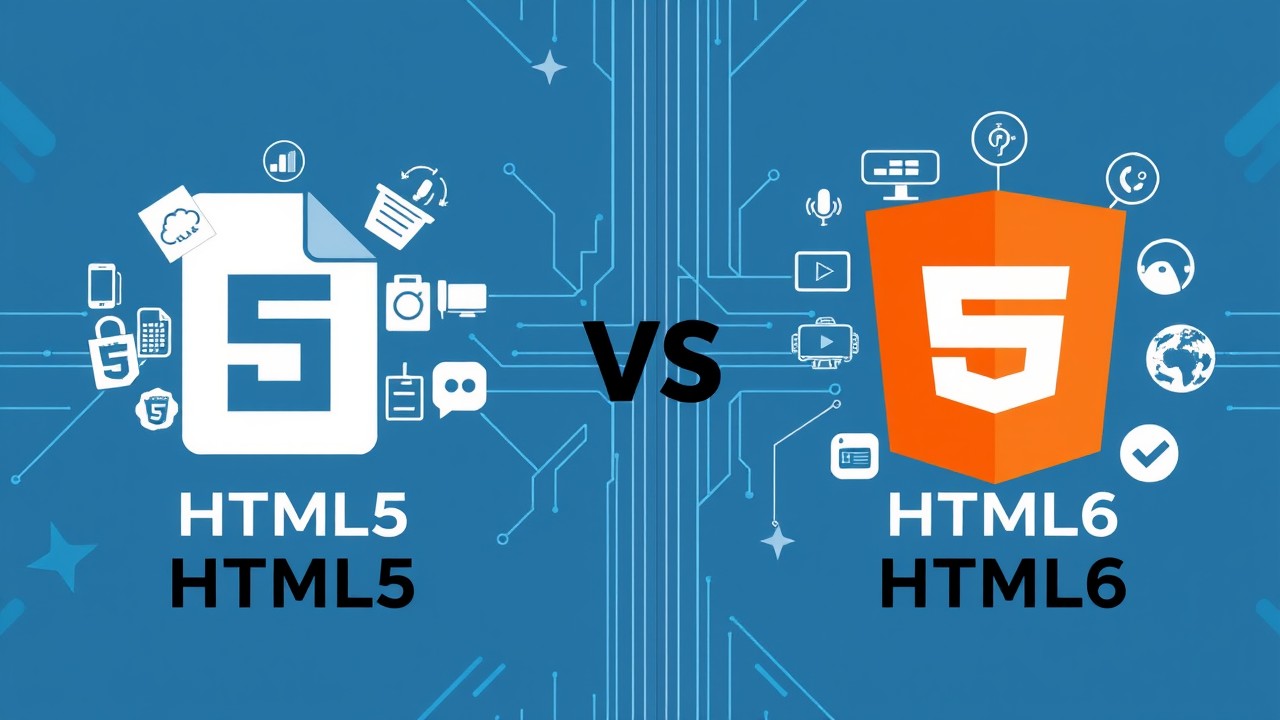HTML5 and HTML6 represent two distinct generations in the evolution of HTML, where HTML5 brought significant innovations, and HTML6 aims to address its limitations while adding powerful, forward-thinking capabilities to enhance web development. As of 2024, while HTML6 remains unofficial, the discussion around its potential features offers a glimpse into the future of web development standards. Let’s dive deep into the differences, advancements, and the potential impacts HTML6 could bring.
HTML6 vs HTML5 comparisons
1. Background on HTML5: Major Features and Limitations
HTML5, introduced in 2014, significantly changed how websites function and look. Key innovations included support for native video and audio without plugins, local storage for offline functionality, and the introduction of semantic elements like <header>, <footer>, <article>, and <section> tags. These advancements allowed developers to create richer, more interactive, and faster web experiences.
However, HTML5 also had its limitations:
- Media Management: Although HTML5 introduced native audio and video support, it offered limited control over video frames, which restricted advanced media manipulation.
- Offline and Real-Time Features: Local storage improved offline capabilities, but developers found limitations in real-time data handling and offline persistence.
- Inconsistent API Integration: HTML5’s APIs, such as Geolocation and Drag-and-Drop, varied in functionality and compatibility across browsers.
These limitations provide a framework for the proposed innovations HTML6 might bring, focusing on more advanced, intuitive, and developer-friendly functionalities.
2. HTML6: Expected Advancements and New Features
HTML6 aims to expand the flexibility, efficiency, and accessibility of web development by improving areas where HTML5 falls short. Below are some anticipated features:
- Native Camera and Microphone Integration: With more users accessing the web on mobile devices, HTML6 is expected to support direct access to device cameras and microphones. This means forms and applications could capture live media directly, making HTML6 more compatible with mobile-first designs and functionalities like video conferencing and direct photo uploads.
- Advanced Video Control and Synchronization: HTML5 allows only basic embedding and playback of videos. HTML6 may enable developers to manipulate video frames directly, providing callbacks and synchronization options, which could revolutionize media-heavy websites and applications, especially for educational and entertainment industries.
- Flexible Image Sizing: HTML5 does not dynamically adjust image quality based on device types, often causing unnecessary data usage on mobile devices. HTML6 could resolve this by allowing developers to specify image sizes more effectively, optimizing performance and providing users with better visual experiences across devices.
3. Enhanced Developer Control: Pluggable Languages and Standard Libraries
One of the anticipated advancements with HTML6 is the ability for developers to use multiple languages and customizable libraries.
- Pluggable Pre-Processors: HTML5 currently supports JavaScript for DOM manipulation and dynamic content generation. HTML6 might allow more flexibility in coding languages and compilers directly within the HTML, such as TypeScript or other language integrations, enabling more powerful, error-free, and readable code.
- Standard Libraries: HTML6 is likely to standardize libraries directly within the browser, such as commonly used JavaScript libraries, reducing the need for external dependencies. This could lead to faster load times and greater consistency across sites by eliminating the need for each site to load its own library versions.
you might like: DIY Macbook Troubleshooting: Common Issues Solved
4. Improved Security and Authentication
HTML6 is expected to address security concerns by introducing advanced, “hard” authentication methods. This could involve secure keys directly within HTML, potentially eliminating the need for cookie-based session management and making authentication both faster and more secure. This approach would be particularly valuable for financial, medical, and e-commerce applications, where data privacy and security are paramount.

- Digital Signatures and Trusted API Access: HTML6 might include APIs that interact only with authenticated software, allowing sites to accept digital signatures and reducing reliance on third-party authentications that can be vulnerable to breaches.
5. Automation and Semantic Markup Enhancements
HTML5 introduced semantic elements that helped search engines and assistive technologies better understand web content. HTML6 is likely to expand on this concept by offering enhanced micro-format support.
- Organized Annotations: HTML6 could allow annotations at a granular level, such as per paragraph, sentence, or even word. This feature would be valuable for education, research, and e-commerce, where detailed descriptions and interactive content are needed.
- Powerful Micro-Formats for Better SEO: HTML6 is expected to enhance SEO capabilities with expanded micro-formats. By enabling more detailed markup for locations, dates, events, and even product details, search engines could interpret content more accurately, improving visibility and indexing.
6. Future-Proofing for Emerging Technologies
HTML6’s enhancements are likely to align closely with emerging tech trends, such as virtual reality (VR) and augmented reality (AR), voice recognition, and AI integration.
- Support for Voice Control and Recognition: HTML6 could include native support for voice recognition, which would allow for voice-controlled navigation, search functionality, and improved accessibility for users with disabilities.
- AR/VR Compatibility: HTML6 is anticipated to incorporate tags and APIs specifically for VR and AR applications. This could allow developers to create immersive experiences directly within browsers, opening up new possibilities for industries like gaming, e-learning, and e-commerce.

7. Impact on Web Development and User Experience
The changes proposed in HTML6 aim to streamline web development, making it more efficient while enhancing the end-user experience. HTML6’s increased control over media, improved performance for mobile and low-bandwidth users, and more robust security standards are set to make websites both more dynamic and more secure.
- For Developers: HTML6’s support for diverse programming languages, improved media handling, and device-specific content rendering would simplify workflows, reduce bugs, and make web apps more performant.
- For End Users: Users would enjoy faster, safer browsing experiences, with richer multimedia interactions and personalized content rendering, especially on mobile devices where HTML6 optimizations would particularly shine.
8. Current Status and the Road Ahead
HTML6 remains in the proposal and development stages, with ongoing discussions about its features and standards. The W3C and other regulatory bodies are exploring HTML6’s specifications, with the goal of setting a new standard for web development that integrates these futuristic capabilities while addressing HTML5’s limitations. It may still be a few years before HTML6 becomes the official standard, but its expected features promise an exciting future for developers and users alike.
In conclusion, HTML6 stands to be a transformative upgrade over HTML5, emphasizing developer flexibility, richer multimedia control, stronger security, and more personalized user experiences. For now, staying informed and experimenting with HTML5 while keeping an eye on emerging HTML6 standards is the best way to stay ahead in web development.

